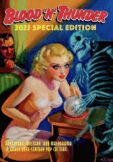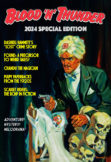EDitorial Comments
2019 Windy City con’s Film Program: Saturday schedule
10:00 a.m. — THE LEOPARD MAN (1943), 66 minutes.
Adapted from “The Street of Jungle Death” (Strange Detective Mysteries, July-August 1939), revised and expanded into the novel Black Alibi by Cornell Woolrich.
Cornell Woolrich’s output—novels and pulp stories combined—was the basis of a good many classic “B” movies and films noir. We’ve already run some of the more obscure; this one is better known and commercially available. But The Leopard Man is such a crackerjack little picture that, after revisiting it at home a couple months ago, we couldn’t resist slotting it into this year’s film program.
The black leopard employed in a nightclub act escapes during an engagement in a small New Mexico town. Following the death of a young girl at the beast’s claws, a posse is formed to hunt the man-killer. Other victims fall prey to the leopard and suffer similarly gruesome fates. Press agent Jerry Manning (Dennis O’Keefe) and his client Kiki Walker (Jean Brooks), for whose act the leopard was rented, are devastated to have been the unwitting cause of this reign of terror. But then evidence surfaces that human agency might be behind the grisly murders. . . .
Third of nine stylish low-budget films produced for RKO by Val Lewton, The Leopard Man was directed by Jacques Tourneur, who also helmed Cat People (1942) and I Walked with a Zombie (1943), the unit’s previous sleeper hits. Made in just four weeks on a budget of less than $150,000, this third Lewton offering exhibits the same ingenuity in maximizing thrills while minimizing expenditures. Robert de Grasse’s cinematography, utilizing clever lighting effects to create an atmosphere of nocturnal terror, can reasonably be characterized as “virtuoso,” and Mark Robson’s editing sustains a measured pace while heightening tension during sequences that depict the stalkings and murders. You’d be hard pressed to find a more suspenseful 66 minutes in any motion picture of the era.
11:15 a.m. — HIGH TIDE (1948), 72 minutes.
Adapted from “Inside Job” (Black Mask, February 1932) by Raoul Whitfield. Reprinted in The Hard-Boiled Omnibus (Simon & Shuster, 1946).
An obscure “B” movie released by humble Monogram Pictures, one of Hollywood’s smallest studios, High Tide some years ago was “rediscovered” by film noir cultists who proclaimed the modest thriller an unjustly neglected work. It had come to our attention in the early 1970s with the private screening of an old, worn 16mm TV print. At that time. though, we were unaware of the original story’s pulp origin.
The narrative gets underway at night, showing us a wrecked car on a beach. One passenger, newspaper editor Hugh Fresney (Lee Tracy), has broken his back in the crash and is immobile. The other, private detective Tim Slade (Don Castle), is pinned beneath the vehicle. Both are certain to drown as the high tide sweeps in. Helplessly awaiting their finish, Fresney and Slade reflect on the strange circumstances that brought them to this point.
Although lacking the bravura visual style of noir classics like Phantom Lady or Out of the Past, High Tide has the archetypal characters familiar to genre devotees: the sultry femme fatale, the cynical private eye, the hapless fall guy, the brutal crime boss, the scheming “big shot” cloaked in wealth and prominence. The narrative is well developed, although noir fans doubtless will figure out what’s going on long before Robert Presnell’s screenplay spells it all out. But this is a taut, compelling film, and one of the very few adapted from a non-series Black Mask yarn.
12:30 p.m. — THE SIN OF NORA MORAN (1933), 65 minutes.
Adapted from “Burnt Offering” (The Underworld, August-October 1930) and “The Woman in the Chair” (Complete Underworld Novelettes, Summer 1932) by Willis Maxwell Goodhue.
Nora Moran has an odd pedigree. Its plot was originally developed for a 1930 pulp novelette that the author, playwright Willis Maxwell Goodhue, subsequently used as the basis for a stage drama, The Woman in the Chair, making significant changes in the process. Then, using the play as inspiration, he composed a new prose version and sold it to another rough-paper magazine! Goodhue primarily wrote breezy comedies for the stage, and Nora Moran was not just his sole property adapted by Hollywood, but also his only melodrama.
Convicted of a murder she did not commit, Nora Moran (Zita Johann) is executed—the first woman in her state to die in the electric chair for 20 years. Her sad story unfolds in a series of flashbacks and hallucinatory interludes, with additional explanation provided by District Attorney John Grant (Alan Dinehart).
Sin of Nora Moran reached the screen as a vanity project undertaken by independent producer Phil Goldstone, who attended a performance of the Goodhue play and saw in it a potential showcase for actress Zita Johann (best known for her role in Boris Karloff’s 1932 horror hit The Mummy), with whom he was infatuated. Goldstone, a highly successful businessman, was best known in Hollywood as a money lender who supplied short-term loans to cash-strapped studios during the Great Depression’s darkest days. A dilettante filmmaker, he not only earned interest on his money but as a courtesy was loaned popular contract players for key roles in his Poverty Row productions. During principal photography Goldstone replaced original director Howard Christie after becoming convinced that the latter wasn’t effectively utilizing his stage-trained star.
Using the then-daring “narratage” technique—which relied on a series of non-chronological flashbacks knitted together by a narrator—the bizarre, morbid Nora Moran today is considered Poverty Row’s meisterwerk, a characterization we’re not prepared to refute. See it and judge for yourself.
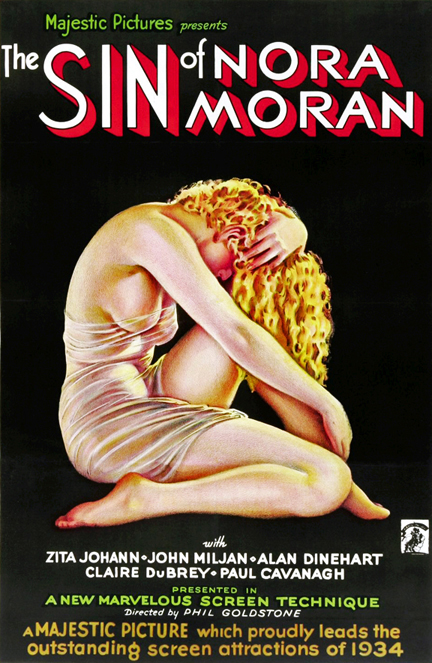
1:45 p.m. — FAST AND LOOSE (1939), 80 minutes.
Adapted from “Fast and Loose” (Argosy, February 25-March 25, 1939) by Marco Page [Harry Kurnitz].
“Marco Page” was the pseudonym employed by critic and journalist Harry Kurnitz for his 1938 whodunit Fast Company, winner of that year’s “Red Badge Detective” contest sponsored by Dodd, Mead & Company. In addition to collecting the thousand-dollar prize, Kurnitz saw his first novel published by Dodd, Mead and quickly optioned by M-G-M, which rushed a film version into production. A murder mystery set in the rarified world of high-end bibliophiles, Fast Company had as its reluctant sleuths the rare-book dealer Joel Glass and his wise-cracking wife Garda. Metro, looking to duplicate the success of its popular “Thin Man” series, cast second-tier stars Melvyn Douglas and Florence Rice in the leads, changing their characters’ surnames from Glass to Sloane.
While not exactly a runaway hit, the Fast Company movie did well enough to justify a sequel, so M-G-M commissioned Kurnitz to write one. In a concession previously granted pulp favorite Max Brand, then providing stories for the studio’s Dr. Kildare pictures, Kurnitz was allowed to sell a prose version of his screenplay to Argosy, which serialized “Fast and Loose” just as the resulting movie was playing its first-run engagements. Unlike the original novel, it never saw print in book form.
The sequel once again embroils Joel and Garda (now portrayed by Robert Montgomery and Rosalind Russell) in a bibliomurder, this one revolving around the theft and potential forgery of a Shakespeare manuscript. The dramatis personae include a shady millionaire, his wastrel son, his trusted broker, an eccentric supermarket tycoon, and a crooked nightclub owner.
The Kurnitz screenplay doesn’t quite reach the mark set by Fast Company. Nor can we honestly say that Montgomery and Russell match Douglas and Rice in their portrayal of the Sloanes. The first film’s stars were relaxed and breezy; the second’s somewhat less so. Their byplay seems forced and ever so slightly inauthentic. Nonetheless, Fast and Loose moves briskly and is a slick, entertaining programmer.
3:15 p.m. — THE SHADOW (1940), Chapters Eight through Fifteen, app. 160 minutes.
Partially adapted from the Shadow Magazine novels “The Green Hoods” (August 15, 1938), “Silver Skull” (January 1, 1939), “The Lone Tiger” (February 15, 1939), and the Shadow radio episode “Prelude to Terror” (January 29, 1939) by Maxwell Grant [Walter B. Gibson].
In these final eight episodes The Shadow’s struggle with the Black Tiger reaches a shattering climax—but not before there’s been plenty of laughs and fast-paced action.
Immediately following Saturday auction — CHEROKEE STRIP (1937), 56 minutes.
Adapted from “Cherokee Strip Stampeders” (New Western, October-November 1936) by Ed Earl Repp.
A burly, red-headed baritone from New Jersey, erstwhile band singer and radio vocalist Dick Foran played small roles in a handful of Fox films (including Shirley Temple’s first starring vehicle, Stand Up and Cheer) before signing a long-term contract with Warner Brothers in 1935. The studio had just decided to reenter the horse-opera market and was about to begin production on a low-budget oater titled The Boss of the Bar-B Ranch. But surprising audience reaction to a warbling Westerner named Gene Autry—seen in a 1934 Ken Maynard picture titled In Old Santa Fe and boosted to stardom in The Phantom Empire, a Western serial with science-fictional trappings—persuaded Warners to enter the singing-cowboy sweepstakes.
Boss of the Bar-B Ranch was retitled Moonlight on the Prairie and slightly rewritten to accommodate two songs performed by newly minted star Foran. Given better-than-average production mounting, Moonlight elicited generally favorable reviews and satisfied audiences. Foran’s acting left something to be desired, although his dime-novel dialogue and caricaturish Texas accent was partially to blame. In subsequent Westerns he delivered relaxed performances, although his robust vocal style always seemed more appropriate to the stage than to the sage.
Cherokee Strip, a reasonably faithful adaptation of Ed Earl Repp’s pulp novelette, has as its background the Oklahoma Land Rush of 1889 and casts Foran as a frontier lawyer who comes to the aid of homesteaders being victimized by cattle rustlers. At a negative cost of approximately $99,000 it was by far the most expensive of the star’s 12 “B” Westerns, but also one of the most successful. The film’s box-office fortunes were heavily skewed by the surprise Hit Parade success of its featured song, “My Little Buckaroo.”
Coming Next Week: THE JOHNSTON MCCULLEY OMNIBUS
Some of you will recall that upon publishing The Return of Black Star, a novel cobbled together from early yarns written by Zorro creator Johnston McCulley for Street & Smith’s Detective Story Magazine, we announced it would be followed by two similar collections by that author. Titled The Thunderbolt Strikes and The Spider Spins His Web, these book-length compilations gathered together the first three novelettes in each of those McCulley series, also published sequentially in Detective Story.
Priced at $19.95, like the other pulp reprints in our line, Return of Black Star didn’t exactly catch fire, sales-wise, and we indefinitely postponed the releases of Spider and Thunderbolt. Having done the time-consuming work of scanning and editing these stories, we’ve decided to publish the material in a different format that originally envisioned, rather than see them languish on the shelf, so to speak.
Therefore, rather than make the trilogy available as three twenty-dollar books, we’re bundling them together between two covers and pricing the jumbo-sized volume at $35—which works out to less than $12 per novel. We realize this will inconvenience those of you who did pay $19.95 for Black Star, but look at it this way: Buying the Omnibus for $35 will still be cheaper then buying Spider and Thunderbolt separately at $19.95 each.
You’ll notice the Omnibus uses the same John A. Coughlin Detective Story painting we put on Black Star‘s cover. Candidly, we feel this piece of artwork is more attractive than those DSM covers heralding publication of the initial Spider and Thunderbolt stories; hence, we’re giving it a second revival. Additionally, the Omnibus will feature an expanded version of the introductory essay we wrote for Return of Black Star.
We’ve completed layout and will be doing a few last-minute tweaks this weekend before registering the title and submitting the corrected digital files to our printer. We expect to get approval and begin soliciting orders by next Friday.

2/1/19: Customer Service Update
We’re happy to report that, finally, our lead time for order fulfillment is shrinking. It’s not quite what it is a year ago and before, but the average order is now being printed and shipped in a week or so (as opposed to the two weeks or more that was common in the last several months). That means most of you can count on receiving your books in about ten days from date of order, sometimes less.
Your continued patience is very much appreciated because, as we’ve stated here previously, the efficacy of our business model—such as it is—relies on a certain number of books purchased at this site, in addition to those sold by Amazon and the various resellers who carry Murania Press product. We make a higher margin of profit on orders placed here, and every dollar counts.
The takeover of our printer by Kindle Direct Publishing has been extremely trying (as it’s been for other small-press publishers serving our niche), but things seem to be improving slowly but surely.
Thanks for sticking with us during this difficult transition.
ART OF THE PULPS on sale!
Hey, gang, I’ve just discovered that Amazon is currently selling copies of The Art of the Pulps, which I co-edited with Doug Ellis and the late Bob Weinberg, for just $21.51 — about 40 percent of its original $49.99 suggested retail price. And if you’re an Amazon Prime member you can get it in two days with free shipping. This is a wholesale price, and was roughly what Doug and I paid for extra copies we purchased upon the book’s publication. I don’t think brand-new copies will ever sell any cheaper, so if you’re looking to buy a Christmas present for yourself and don’t already have AotP, now’s the time. I just bought a couple more copies for my own files!
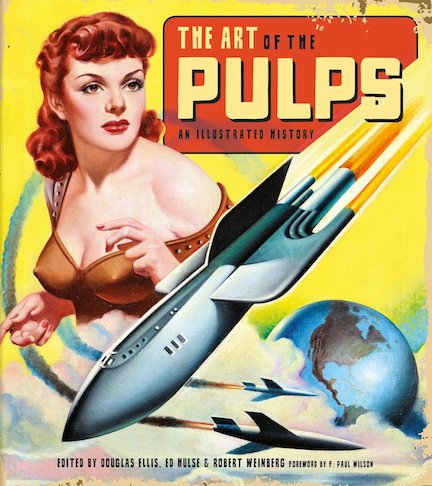
Coming Soon: SATAN LIVES FOR MY LOVE!
A few particularly lurid magazines hold special places in the brief but storied history of the “weird menace” pulps: those published during the late 1930s by Martin Goodman, whose holdings would soon include the four-colored ancestors of the Marvel Comics empire. Among Goodman’s “Red Circle” group were Mystery Tales, Uncanny Tales, Marvel Tales, and Real Mystery—pulps that reached new heights (or, rather, plumbed new depths) of depravity with their blood-curdling, stomach-churning narratives built around sex and sadism.
Next month Murania Press will release Satan Lives for My Love!, an anthology of salacious, spine-chilling stories culled from the notorious Red Circle horror pulps. Outrageously outré for those late Depression years, these paraphilia-crammed yarns still, some 80 years later, retain their ability to shock even the most jaded readers. The adjectival phrase “envelope-pushing” easily could have been coined to describe the terrorific tales that spilled from the woodpulp pages of these periodicals like entrails from the bellies of their disemboweled victims.
Subscribing to the dictum “sex sells,” Red Circle’s editorial director Robert O. Erisman encouraged his contributors to wallow in licentiousness. This preoccupation with thinly veiled carnality was manifest not only in the company’s weird-menace titles but in its detective pulps and even in Marvel Science Stories, its first science-fiction magazine. Playing up sexual content was a way of distinguishing the line, which attracted second-rare fare because Goodman rarely paid more than a half-cent per word.
Mystery Tales, the first Red Circle weird-menace pulp, started off fairly tame. Like others of its type, the magazine initially published stories in which the threat of sexual violence was always present but rarely carried through. Presumably with Goodman’s knowledge and blessing, Erisman decided to increase its sleaze quotient. Completely throwing off the shackles of good taste, he instructed writers to devote considerable wordage to graphic depictions of torture, almost exclusively inflicted on women. Previously the protagonist’s wife or sweetheart always escaped physical punishment, if only at the last possible second. But by late 1939 all bets were off, and it was not uncommon for female leads to undergo floggings and worse, although the most gruesome fates were reserved for secondary characters.
Red Circle writers trafficked in sexual perversion to a startling degree. The pages of Mystery Tales, Uncanny Tales, and the others teemed with examples of sadism, masochism, necrophilia, and even hints of bestiality. Rapes were never explicitly described, but one needn’t read much between the lines to know it was happening. Young women always made the most alluring victims, and under Erisman their ages dropped precipitously. Sixteen-year-old heroines were not uncommon.
Most yarns were supplied by a small group of contributors—Bruno Fischer, Don Graham, Ray Cummings, Mary Dale Buckner, Arthur J. Burks, Allan K. Echols, and Robert Leslie Bellem—occasionally writing under their own names but also using a battery of house names and pseudonyms.
Satan Lives for My Love! collects the (curdled) cream of this crop: tales skimmed from all four titles, representing the mainstays named above. The 100,000-word collection includes Ed Hulse’s introductory essay “Unholy Jitters: Sex & Sadism in Red Circle’s Horror Pulps,” originally written for Blood ‘n’ Thunder #2 and reprinted several times by popular demand, most recently in The Blood ‘n’ Thunder Sampler. The book’s cover sports a J. W. Scott painting originally used on the July 1939 issue of Mystery Tales.
As high-grade copies of Red Circle horror pulps typically sell to collectors for hundreds of dollars each, this jumbo-sized book’s $25.00 price tag makes it a bargain. If you’ve got a strong heart and a stronger stomach, by all means try Satan Lives for My Love! We guarantee you’ll find it surprising, at the very least.
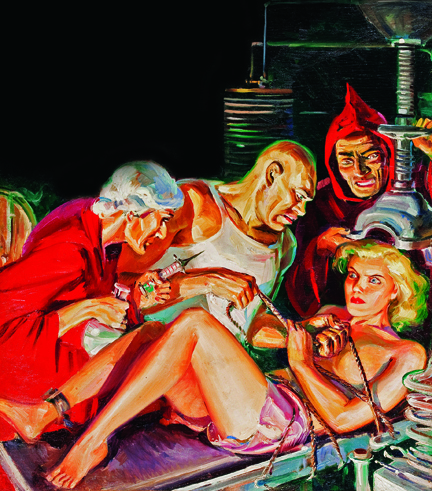
Holiday-Season Sale Begins Today!
The biggest, longest sale in Murania Press history begins today, November 23.
Until New Year’s Eve most of our books will be available at a discount of not 20, not 25, but 30 percent off cover price. For obvious reasons we’re excluding our most recent releases, Behind the Mask, Those Sexy Serial Queens, and the newly revised Blood ‘n’ Thunder Guide to Pulp Fiction. And we’re holding the discount to 20 percent on Flickering Shadows.
If you plan on purchasing our books as Christmas presents and want to receive them before December 24, we strongly advise you to buy sooner rather than later, as increased seasonal demand doubtless will add to the delays our printer is already experiencing. At present it’s taking two weeks for them to print and ship books for us. Most packages are sent from their South Carolina plant via UPS Ground, so customers on the West Coast should add another week for delivery. We regret the long lead time in fulfilling orders, but as stated in a previous post, we’re at the printer’s mercy. Hopefully the steep discount we’re offering will compensate for the lengthier-than-usual wait.
We can offer, on a limited basis, immediate shipping of a few titles on which we have extra copies in stock. These include Blood ‘n’ Thunder Presents, Volume One: Pride of the Pulps; Blood ‘n’ Thunder Presents, Volume Three: Fighting Crime One Dime at a Time; The Blood ‘n’ Thunder Sampler, and Flickering Shadows. Likewise, we have a few extra copies of several reprinted novels: Barehanded Castaways, The Perils of Pauline, Pirates of the Pines, The Purple Eye, and The Wilderness Trail. Please be advised, however, that our copies in hand are limited.
As always, our sale prices include shipping to the domestic United States. Buyers from Alaska, Hawaii, and other countries must inquire for shipping rates before they make a purchase.
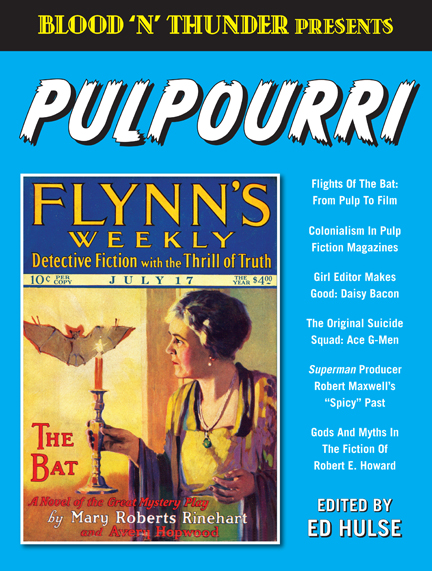
An Important Announcement for Murania Press Customers
As we write these words, Murania Press has arrived at a turning point in its 11-year history.
Those of you who’ve been loyal customers since we published The Blood ‘n’ Thunder Guide to Collecting Pulps in 2007 know that we’ve subscribed to the POD (Print On Demand) model of small-press publishing, which obviates the necessity of maintaining large inventories and printing books in quantities of 500 or 1000 copies to get a feasible unit cost. We began with a printing company then called Lightning Source but in 2009 transferred our allegiance to an outfit named CreateSpace, which offered cheaper unit costs and had the added benefit of being allied with Amazon.
That year we brought Blood ‘n’ Thunder to CreateSpace as well, and since then every Murania Press publication has been printed by them. Our books and magazines, with rare exceptions, were produced at and shipped from their South Carolina plants in Charleston and Columbia. While there have always been delays in processing large orders (such as our shipments to wholesale customers), for the most part we were able to fulfill single-copy orders expeditiously.
Last year we began noticing delays in single-copy shipments, and this year the situation has gotten steadily worse. It’s currently taking CreateSpace an average of ten business days to print and ship one book. We’ve complained repeatedly but to no avail. Things took a turn for the worse following September’s Hurricane Florence, which pounded the Carolinas and flooded the areas where CreateSpace’s plants were located.
The rollouts of our two most recent publications, Behind the Mask and Those Sexy Serial Queens, have been close to disastrous as a result of CreateSpace’s snail-like service. We deserve some of the blame for delays in early shipments of Mask, which had to be recalled to address a serious copyright-page omission regarding current ownership of The Lone Ranger. But even after processing the corrected files we sent, CreateSpace dragged its feet on fulfilling the initial batch of orders, resulting in month-long waits for customers.
Being now owned by Amazon (which is in the process of folding it into Kindle), CreateSpace has naturally been more prompt fulfilling orders for our books placed with Amazon. Of late there have been whispers among small-press publishers that this is a deliberate strategy to drive more business to that corporate behemoth at the expense of marginal operators like us. Apparently Jeff Bezos and his underlings don’t have enough money already.
We are keenly aware of dissatisfaction among those who purchase Murania Press books via our website. All year long we’ve fielded your e-mails. Most people have been understanding, some have not. We’re acutely aware Amazon has made rapid shipping so easy, and for no extra cost to Prime members, that customers don’t want to wait two weeks for a book from us when they can get it from Amazon in two or three days.
The problem is that we can’t survive on Amazon royalties, which return to publishers significantly less money than they can make by selling their wares directly via website. That’s why, even though fully aware of the inconvenience involved, we’re asking you to keep purchasing Murania Press products directly from us — even though you’ll have to wait longer to receive them.
We’ve established a reputation for non-fiction books that are well researched, well written, and well edited. We provide the handsomest editorial packages our limited budgets will allow. But it requires enormous investments of time and effort to turn out products of the quality we maintain, and unless we can meet a certain profit threshold we won’t be able to continue.
In recognition of the current difficulties, we’re taking steps to guarantee better service during the upcoming Christmas shopping season. Even though it runs contrary to the POD model, which was supposed to free us from the necessity of fronting money for inventory, we’re already ordering quantities of the books on which we intend to run holiday-season sales. Come early December we’ll have them on hand and will ship directly to you without relying on CreateSpace for short-order fulfillment. Obviously, if we run out of stock early on certain items, we’ll have to reorder and keep our fingers crossed for timely shipments from the plant.
What happens in the future? Well, we’re already looking for viable alternatives to CreateSpace. Unfortunately, the most likely is also vastly more expensive: our unit costs would practically double, forcing us to raise prices or accept greatly reduced profit margins. So we’re still looking.
During this difficult period we’re asking that you stick with us, even if it means longer wait times. Otherwise we’ll have to close down — and we don’t want to do that.
Watch this space for future announcements about future developments at Murania Press.
Collectibles Update
Two weeks ago we added approximately 30 new items to our Collectibles for Sale section but forgot to post anything here about the update. Well, consider yourselves informed. A number of choice items have been sold but many remain. And we dropped prices on a few that have been lingering in that space for some time now.
Check it out; there are interesting pieces available at excellent prices. And remember, shipping to the continental United States is included in each item.
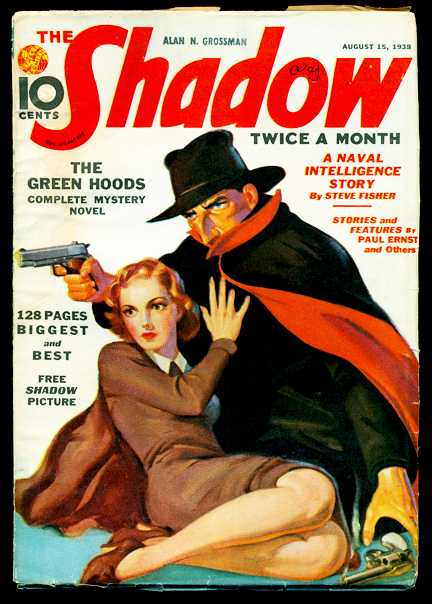
October Overstock Sale
We’re currently overstocked on several Murania Press titles, left over from our exhibits at recent hobbyist confabs. Therefore, we’re offering them at 20 percent off list price as long as supplies last, which we don’t believe will be very long.
The books on sale include Pride of the Pulps (Blood ‘n’ Thunder Presents, #1), Fighting Crime One Dime at a Time (Blood ‘n’ Thunder Presents, #3), Flickering Shadows, and The Blood ‘n’ Thunder Sampler.
The sale price has already been attached to each book’s page here on the site. Again, these are copies that are already on hand and available for immediate shipping.
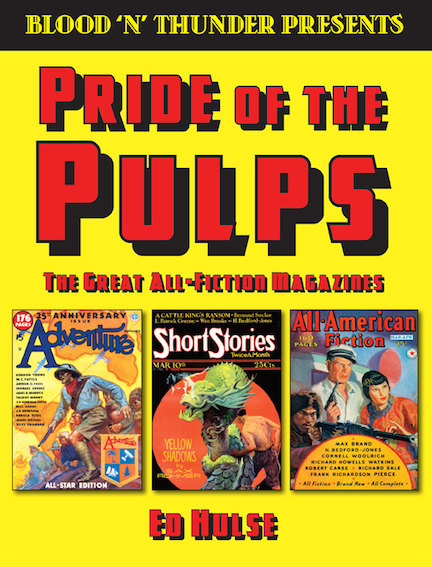
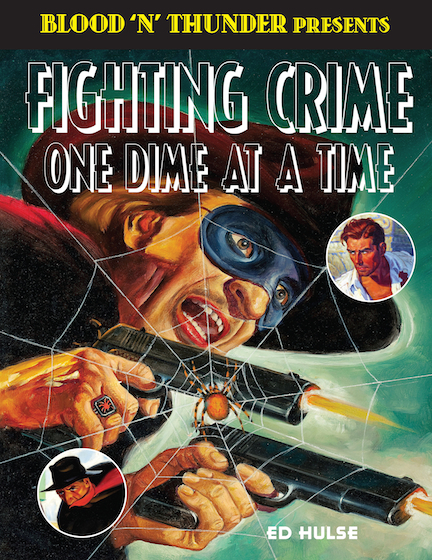

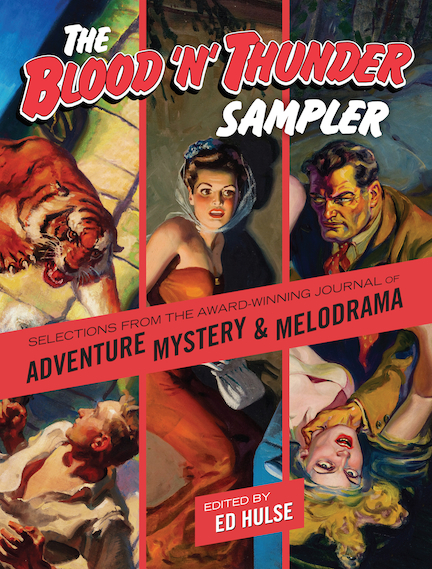
Recent Posts
- Windy City Film Program: Day Two
- Windy City Pulp Show: Film Program
- Now Available: When Dracula Met Frankenstein
- Collectibles Section Update
- Mark Halegua (1953-2020), R.I.P.
Archives
- March 2023
- July 2021
- May 2021
- March 2020
- February 2020
- December 2019
- November 2019
- October 2019
- September 2019
- August 2019
- May 2019
- April 2019
- March 2019
- February 2019
- December 2018
- November 2018
- October 2018
- August 2018
- June 2018
- February 2018
- December 2017
- October 2017
- September 2017
- August 2017
- May 2017
- April 2017
- February 2017
- September 2016
- August 2016
- July 2016
- June 2016
- November 2015
- October 2015
- September 2015
- August 2015
- July 2015
- June 2015
- May 2015
- April 2015
- March 2015
- February 2015
- January 2015
- August 2014
- July 2014
- June 2014
- May 2014
- April 2014
- January 2014
- December 2013
- September 2013
- August 2013
- July 2013
- June 2013
- May 2013
- April 2013
- March 2013
- February 2013
- January 2013
- December 2012
- October 2012
- September 2012
- August 2012
- July 2012
- June 2012
- May 2012
Categories
- Birthday
- Blood 'n' Thunder
- Blood 'n' Thunder Presents
- Classic Pulp Reprints
- Collectibles For Sale
- Conventions
- Dime Novels
- Film Program
- Forgotten Classics of Pulp Fiction
- Movies
- Murania Press
- Pulp People
- PulpFest
- Pulps
- Reading Room
- Recently Read
- Serials
- Special Events
- Special Sale
- The Johnston McCulley Collection
- Uncategorized
- Upcoming Books
- Western Movies
- Windy City pulp convention
Dealers
Events
Publishers
Resources
- Coming Attractions
- Field Guide to Wild American Pulp Artists
- MagazineArt.Org
- Mystery*File
- ThePulp.Net



